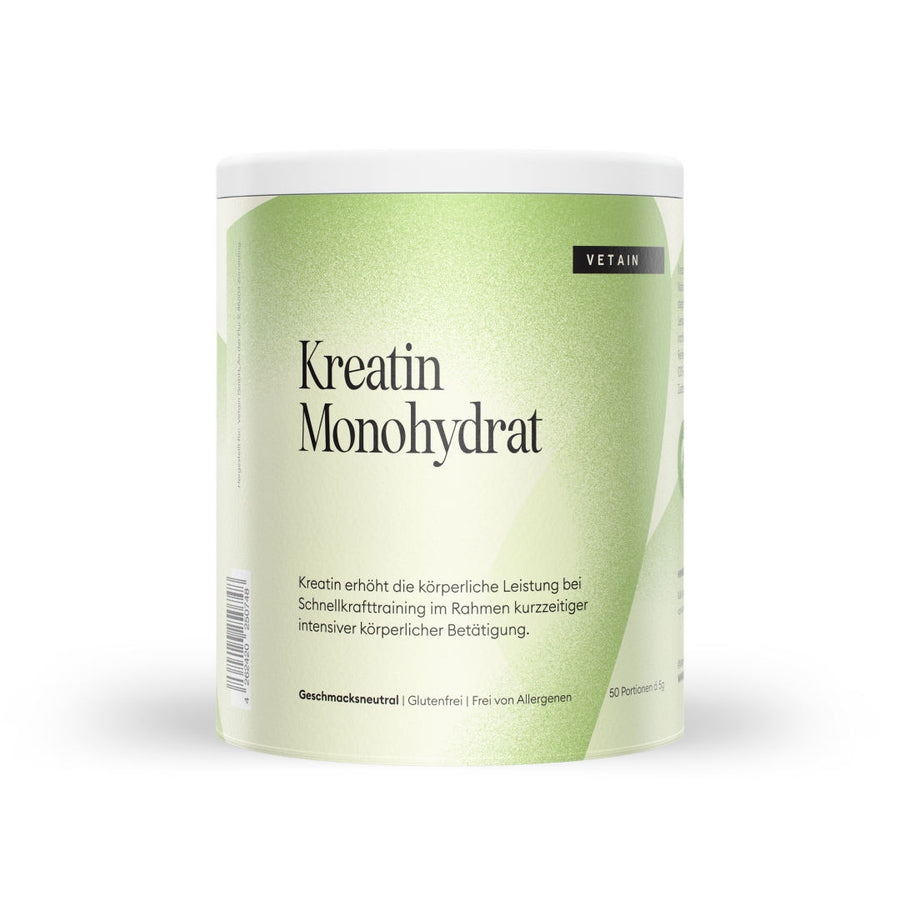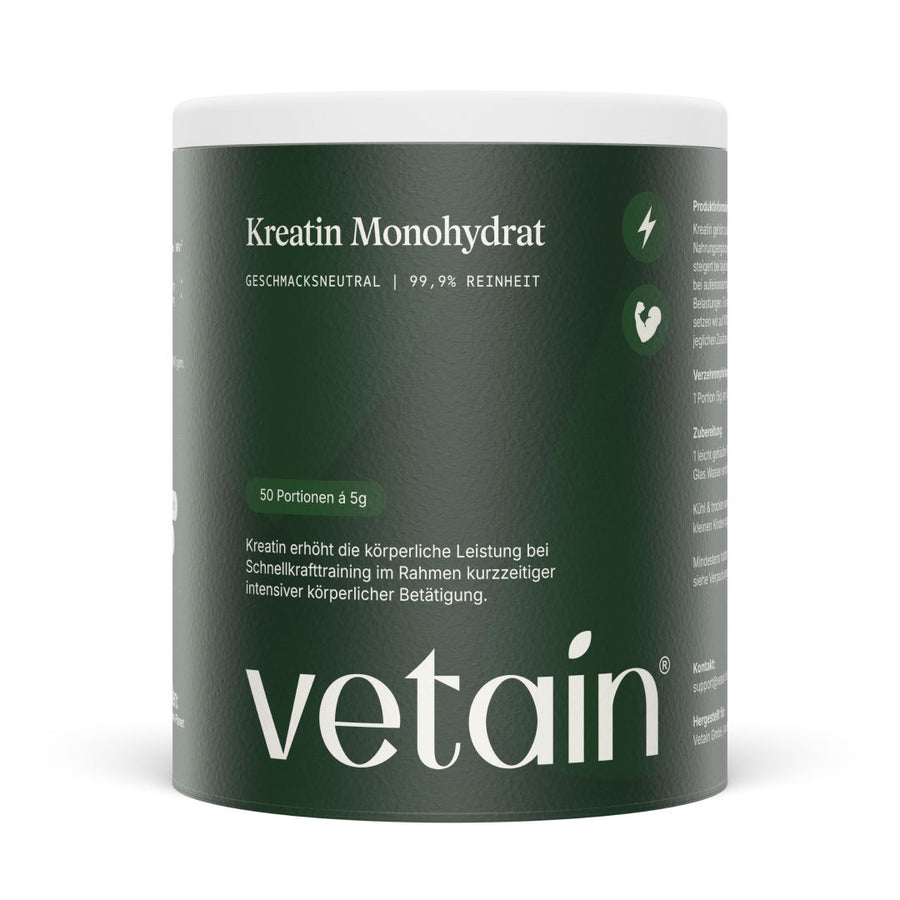Creatine is on everyone’s lips right now—literally. And while most of us probably know that creatine plays an important role for muscles, many don’t really know what creatine actually is. That’s exactly what we’ll figure out together in this article, so you can join the conversation at your next gym session.
So, what is creatine, anyway? And what do dinos have to do with it?!
Your takeaway: What is creatine?
Creatine is produced with the help of amino acids and occurs naturally in our bodies.
The body can make creatine on its own, and it can also be obtained from animal products or supplements.
An intake of up to 3 g/day is considered safe for healthy adults.
Creatine explained simply
Creatine is a carbon–nitrogen compound. Wait, what? That doesn’t make us much wiser yet. What does that even mean? What is creatine—in simple terms?
Creatine is a substance formed with the help of amino acids (the building blocks of proteins) and plays an important role in the muscle energy metabolism. Put very simply, creatine helps ensure a steady energy supply for our muscles.
Back to that technical term for a second: “carbon–nitrogen compound” sounds complicated, but you already know other examples—proteins and even our DNA fall into that category. Got it?
Adults are estimated to turn over about 1.5–2 grams of creatine per day.
Humans produce creatine in the body. The amino acids arginine, methionine, and glycine are needed for this. Let’s take a quick look at how that works—no deep biochemistry dive, promise. Afterward, we’ll better understand what creatine is.
Creatine is formed in the liver from a substance called guanidinoacetate with the help of methionine. Aha—there’s our “dino”… less spectacular than expected. Guanidinoacetate is made from the amino acids glycine and arginine in the pancreas and kidneys. In addition, if you eat meat and fish, creatine can also be obtained through food.
The creatine produced (or ingested) then travels through the body: from the gut or liver into the blood and onward to the areas where creatine is needed. The main destination is our skeletal muscles. About 90% of creatine is stored there as creatine phosphate. The remaining ~10% is transported to other areas like the brain.
Good to know: Creatine phosphate
(also PCr or phosphocreatine):
Creatine phosphate is a compound of creatine and phosphate—think of creatine as having “adopted” a phosphate group.
We’ve now clarified what creatine is. But what about “creatine/creatin”? Easy: it’s all the same thing!
Time to move on to the important stuff:
What creatine does in the body – properties and effects
We’ve learned what creatine is. We often hear it’s “good”—but what does it actually do in the body?
In principle, muscles need creatine because creatine phosphate is an energy donor. That’s why many active people use creatine to try to build muscle effectively. That’s probably its best-known role.
There’s also research into further potential uses; however, no authorized health claims exist to date:
Brain
Nervous system
Mental health
Immune system
As you can tell, creatine is important for our bodies. For this reason, an adult has a creatine store of about 120–150 g to always have enough on hand!
Creatine in sports – training and performance
Creatine is touted online as a game changer in sports that promises better training performance. What’s behind that?
Creatine can provide energy to our muscles very quickly and increases physical performance in successive bursts of short-term, high-intensity exercise. The beneficial effect is obtained with a daily intake of 3 g of creatine. Some studies are also investigating whether creatine might play a role in recovery, muscle soreness, or injury risk. So far, results are mixed and no effects are definitively established. How it all works, what role type II muscle fibers play, and what else creatine can do is explained in more detail in our article “What does creatine do?”—where you’ll also find more on the benefits and effects of creatine.
Creatine and our kidneys
There’s a connection between creatine and our kidneys. Not only are building blocks for creatine produced there—the kidneys also help convert creatine to creatinine and excrete it in urine. By the way, your doctor may sometimes check your creatinine—maybe that’s why the term sounds familiar.
We’ll get to whether creatine (as is often assumed) is harmful to our kidneys later!
Creatine in the diet
We now understand what creatine is and what it does—my brain’s already smoking. So how do we get it? What foods contain creatine?
Creatine is found mainly in meat and fish. The name says it all—“creatine” comes from the ancient Greek word for meat. (Cow’s) milk can also be a source, but it contains much less than meat.
Bad news for vegetarians and vegans: fruits and vegetables contain hardly any creatine. Now what?
Creatine in vegetarian and vegan diets
As mentioned, creatine is mainly present in animal products. This raises a big question for vegetarians and vegans: how do you get enough? Does the body have to work overtime to make more?
In short: yes. People who consume little creatine from food simply make it themselves. That’s not an issue—the body generally isn’t reliant on dietary creatine to cover its basic needs and can largely meet its needs endogenously. Dietary creatine is basically a “bonus.”
Just make sure you get enough of the essential amino acid methionine, which is required to produce creatine. Without it, no creatine can be formed!
Vegetarian and vegan individuals do tend to have slightly lower creatine stores. If you want to top up your stores and make faster progress in training, supplementation could be interesting for you.
%-product_content-%
Creatine supplementation
Creatine is increasingly in focus—especially for active people, but also for vegetarians and vegans—and many already take creatine supplements.
Do you actually need it? Especially if you’re currently under a lot of stress, not eating ideally (or eating fully plant-based), or doing a lot of demanding training, creatine supplementation can be worth considering.
If you’d like to read more about how to supplement creatine, check out our articles on creatine intake and on timing your supplementation. There you’ll find all the key info—including how much creatine to take per kg.
And you’ll also find the right creatine supplement in our shop.
%-split_content-%
Risks and downsides of creatine
You’ll often see warnings and scary side effects about creatine online. Many people are still unsure whether supplementation is really safe. We get it! It’s unsettling when you don’t know or can’t assess something. That’s why we’re here to give you an honest, science-based view.
By the way: you can trust that in our shop for protein powders and supplements we only ever offer safe products—your health and well-being come first for us!
Back to the topic:
Does creatine have side effects?
There are isolated reports of side effects—of course, why would creatine be any different from other foods? There’s probably always someone out there who doesn’t tolerate a product. There’s even such a thing as a water allergy!
Several large, comprehensive studies have now examined the issue and bring good news: side effects are rare. See for yourself:
Possible side effects in rare, individual cases and at very high doses (beyond the recommendation):
Bloating
Mild diarrhea
Muscle cramps
If you stick to the recommended intake and choose a high-quality creatine supplement, side effects are uncommon.
What can happen, though, is a slight increase in body weight, since creatine promotes water uptake into the muscles. That’s also behind the “fuller” muscle look. Whether that’s an unwanted side effect or a bonus is up to you.
Creatine safety: scientific assessment
Is creatine harmful? The European Food Safety Authority (EFSA) confirmed more than 20 years ago that daily supplementation of up to 3 g of creatine is safe for adults—assuming you’re healthy and your creatine is free from heavy metals and other contaminants. As mentioned, quality matters.
Other large, representative studies have likewise found no harmful effects from creatine supplementation—over short or longer periods—when intake recommendations are followed.
For healthy individuals, recommended amounts of creatine also don’t appear to affect the kidneys negatively. If you have conditions that affect the kidneys (or could), seek medical advice before supplementing.
Once you understand what creatine is, this assessment makes sense; after all, they’re just amino acids in another form.
Conclusion: Creatine at a glance
Here are the key points at a glance, so you can easily answer “What is creatine?” in the future: creatine is a substance in our body formed with the help of amino acids. Creatine plays important roles across many bodily processes. It’s best known for its importance in sports. At recommended doses, creatine is generally well tolerated.
Give it a try and tell us about your experience!
Literatur & Quellen
EFSA NDA Panel (EFSA Panel on Dietetic Products, Nutrition and Allergies) (2016). Scientific opinion on creatine in combination with resistance training and improvement in muscle strength: evaluation of a health claim pursuant to Article 13(5) of Regulation (EC) No 1924/2006. In: EFSA Journal, 14(2).
Kreider, R. B. et al. (2017). International Society of Sports Nutrition position stand: safety and efficacy of creatine supplementation in exercise, sport, and medicine. In: Journal of the International Society of Sports Nutrition, 14(1).
Swiss Sports Nutrition Society (2023). Supplementguide. A-Supplemente: Performance Supplement. https://www.ssns.ch/wp-content/uploads/2023/12/SSNS-SG-Kreatin_V2.2.pdf
Got questions? Then feel free to send me an email—I’m happy to hear from you! :)
The information in this article does not replace individual medical or nutritional advice.















 7 Min
7 Min
 Zuletzt aktualisiert am 30.10.2025
Zuletzt aktualisiert am 30.10.2025




